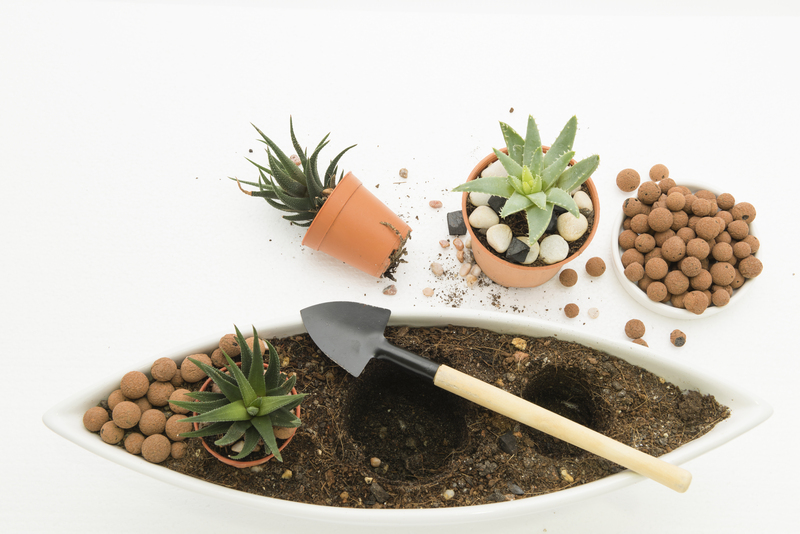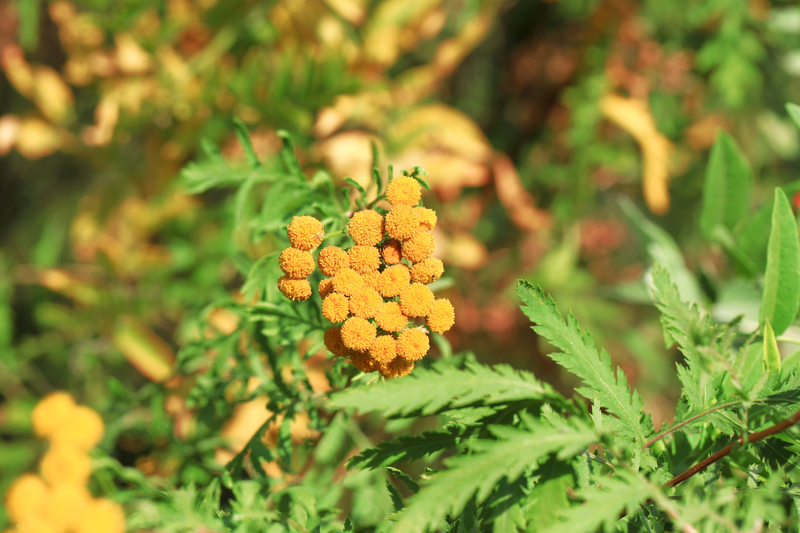Empowering Tips to Keep Garden Plants Secure in Winter
Posted on 23/09/2025
Empowering Tips to Keep Garden Plants Secure in Winter
As winter approaches, gardeners often worry about the safety of their beloved plants. Cold temperatures, frost, and unpredictable weather can all pose significant threats to garden vitality. But with the right preparations and knowledge, you can ensure your green sanctuary remains healthy and vibrant throughout the chilliest months. In this comprehensive guide, we'll share empowering tips and strategies to keep garden plants secure in winter, helping both novice and seasoned gardeners.

Understanding The Winter Threat: What Endangers Garden Plants?
To develop a robust winter garden care strategy, it's vital to understand the risks that winter poses to your plants. Garden plants face threats such as frost, snow, desiccating winds, and fluctuating soil temperatures. Sudden changes in weather can disrupt plant dormancy, while heavy snow or ice can physically damage stems and branches. Some plants are especially vulnerable, including tender perennials, young saplings, and container plants.
- Frost Damage: Frost can cause the water inside plant cells to freeze, damaging or killing plant tissues.
- Desiccation: Cold, dry winds can pull moisture from foliage, especially evergreens, leading to winter burn.
- Root Stress: Temperature fluctuation in the soil can harm fragile roots, especially during freeze-thaw cycles.
- Physical Damage: Heavy snow and ice can break branches or crush delicate plants.
Tip 1: Choose Winter-Hardy Plant Varieties
Selecting the right plants is the first empowering step to ensure garden security in winter. Research which species thrive in your local climate. Native and well-adapted plants are generally more resilient to your zone's winter patterns. When planning new gardening projects, prioritize hardy perennials and robust shrubs over tender annuals if winter protection is a concern.
- Consult the USDA Plant Hardiness Zone Map to select plants suited to your area.
- Group vulnerable plants together so they can benefit from shared protection strategies.
- Consider moving tender container plants indoors well before the first frost.
Tip 2: Mulch for Temperature and Moisture Control
Applying mulch is one of the most trusted methods for keeping garden plants safe in winter. Mulch acts as an insulating blanket, stabilizing soil temperature and retaining moisture around the plant roots. It also helps suppress winter weeds and prevents soil heaving caused by freeze-thaw cycles.
How to Mulch for Winter Protection:
- Use organic materials like shredded leaves, straw, pine needles, or bark chips. These decompose over time, enriching soil nutrients.
- Apply 2-4 inches of mulch around the base of your plants, but avoid piling mulch against stems or trunks, which can cause rot.
- Mark the edges of mulched beds for easy identification under snow cover.
Tip: Wait until the ground is slightly frozen before mulching. This avoids attracting rodents seeking warmth, who may damage plant roots or bark.
Tip 3: Shield Plants from Harsh Winds and Frost
Protecting your garden plants from winter winds and frost is critical for their safety. Cold, dry winds can be more damaging than frost alone, especially for broadleaf evergreens. Frost can also strike suddenly, so proactive measures are crucial.
Wind and Frost Protection Ideas:
- Install windbreaks using burlap, snow fencing, or temporary screens on the windward side of vulnerable plants.
- For small plants and seedlings, utilize garden cloches, row covers, or overturned buckets during frost warnings.
- Create DIY plant wraps from horticultural fleece or burlap for shrubs and small trees. Wrap loosely to allow air circulation while offering protection.
- For evergreen shrubs, use anti-desiccant sprays to help foliage retain moisture during the driest periods.
Tip 4: Watering Wisely Before Winter Sets In
Proper hydration helps plants weather the winter cold. Well-watered soil retains heat better and helps protect roots from freezing temperatures. Autumn is a crucial time to ensure soil moisture levels are optimal.
- Deeply water your garden plants in late fall, especially evergreens and newly planted trees.
- Continue watering during dry winter spells when the ground is not frozen.
- Avoid overwatering, as soggy soil can lead to root rot during cold weather.
Empowering Tip: Mulching after watering locks in soil moisture and prevents quick evaporation.
Tip 5: Prune and Maintain Plants Before Dormancy
Regular pruning and plant care in autumn strengthen your garden's defenses for the winter. Remove dead, diseased, or damaged branches, as these can harbor pests and increase vulnerability to snow or ice damage. Proper pruning shapes plants and minimizes the risk of breakage during storms.
- Trim back perennials to a few inches above ground, except those providing winter interest or wildlife habitat.
- Cut back any overgrown or crossing branches on shrubs and trees.
- Sterilize your pruning shears between uses to prevent the spread of disease.
- Avoid major pruning in late fall, as this may stimulate new growth susceptible to winter injury. Save major pruning for late winter or early spring.
Tip 6: Provide Extra Care for Container Plants
Container and potted plants face greater risks in winter due to their limited root insulation and exposure. With a tailored approach, these plants can be kept secure and healthy until spring.
- Move containers to sheltered spots such as garages, greenhouses, or against south-facing walls for extra warmth.
- Wrap pots in bubble wrap, fleece, or burlap to provide added insulation for roots.
- Raise pots off the ground with bricks or pot feet to improve drainage and prevent waterlogging.
- For hardy perennials in pots, group them together and mulch around the containers for shared warmth.
Tip 7: Monitor Snow and Ice Accumulation
Heavy accumulations of snow and ice can be catastrophic to delicate branches and small shrubs. Regularly check your garden during winter storms and take action when needed.
- Gently brush off heavy snow from branches using a broom, moving upward to avoid breaking brittle wood.
- Avoid shaking ice-laden branches, which can snap easily; allow ice to melt naturally.
- Support young or top-heavy trees and shrubs with stakes or ties before winter storms arrive.
Tip 8: Use Row Covers and Cloches for Added Security
Row covers, horticultural fleece, and cloches are fantastic tools to keep your garden plants secure in winter, especially during sudden cold spells. These devices trap warmth, protect from frost, and keep out hungry animals.
- Install floating row covers directly over vegetable beds and low-growing perennials.
- Utilize glass or plastic cloches over individual plants or seedlings to create mini-greenhouses.
- Firmly secure covers at the edges to prevent wind from dislodging them.
- On sunny days, temporarily lift covers to prevent overheating and encourage air circulation.
Tip 9: Adapt to Your Local Climate
Every garden is unique, and so is every winter. Understanding your local climate patterns and microclimates can help tailor your winter plant protection strategies.
- Watch local weather forecasts for frost dates, temperature drops, and winter storm warnings.
- Take note of spots in your garden that are prone to frost pockets, wind tunnels, or excessive shade, and adjust plant placements accordingly.
- Grow more tender plants in spots with reflected heat, such as near stone walls or south-facing areas.
Tip 10: Support Wildlife and Biodiversity
Your winter garden doesn't have to be void of life. Leaving some plant matter, like seed heads or ornamental grasses, not only provides essential food and shelter for overwintering birds and beneficial insects, but can also enhance your garden's beauty and resilience.
- Allow some perennials to remain uncut for winter structure and wildlife support.
- Install bird feeders and fresh water sources to attract garden allies.
- Avoid using chemical pesticides, which can harm helpful pollinators and cause ecological imbalance.
Essential Winter Plant Security Checklist
- Assess garden for vulnerable plants in fall.
- Mulch, water, prune, and cover as appropriate.
- Monitor regularly for weather changes and physical damage.
- Adjust techniques based on plant type and local conditions.
Bonus: Common Winter Garden Mistakes to Avoid
- Forgetting to water evergreens during dry spells.
- Over-mulching or piling mulch against stems, leading to rot.
- Neglecting container plants or leaving clay pots outdoors, which can crack in frost.
- Using plastic sheeting directly on plants--it can lead to moisture buildup and rot. Use breathable fabrics instead.
- Delaying winter preparations until after the first hard frost.

Conclusion: Take Proactive Steps to Secure Your Garden Plants for Winter
Keeping your garden plants secure in winter doesn't have to be a daunting task. By practicing thoughtful winter gardening techniques, staying attentive to your local conditions, and employing these well-researched empowering tips, you'll give your plants the best chance for survival and growth come spring. Remember, preparation and proactive care are the keys to a healthy, resilient, and beautiful winter garden.
Whether you're protecting delicate perennials, ambitious trees, or cherished container gardens, these strategies will help you overcome the harshest of winters and enjoy a flourishing landscape year after year.
Frequently Asked Questions About Keeping Garden Plants Secure in Winter
-
How much mulch should I use to protect my garden in winter?
Apply 2-4 inches of mulch around the base of your plants, avoiding direct contact with stems or trunks. -
Should I water my garden during winter?
Water evergreens and new plantings during dry spells when soil is not frozen to prevent root desiccation. -
Are all plants at risk in winter?
Tender perennials, evergreens, and young trees are most vulnerable. Native and established hardy plants face fewer risks but still benefit from some protection.
Keep these empowering winter garden tips in mind and you'll be rewarded with healthy, thriving plants when the snow melts and your garden springs back to life!

